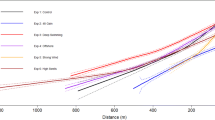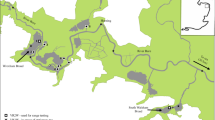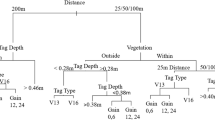Abstract
Fine-scale spatial acoustic telemetry, including hyperbolic and centre-of-activity localisation, is widely used to provide insight into the ecology of aquatic animals. However, these positional telemetry systems require numerous receivers, even for limited study areas such as narrow rivers, creeks, and canals, where tagged animals are typically monitored by receivers deployed at locations of particular interest or across a water body (acoustic gate). This paper proposes an acoustic zone monitoring method, which only uses a few acoustic receivers to estimate a zone used by a tagged fish in narrow water bodies. The effectiveness of the proposed method was verified by performing stationary and moving tests and by monitoring the movements of an invasive species in Japan, the channel catfish Ictalurus punctatus. Eight acoustic receivers were deployed 100–270 m apart along the river, with each zone having a length of 100–190 m. The proposed method provided accurate estimates in the inner and outermost zones of the eight stationary transmitters (100%, number of estimates: 1118 ± 419) and of a single transmitter towed by a boat (99.1%, number of estimates: 111/112). By contrast, centre-of-activity localisation estimated positions around the centre of the receiver array, and hyperbolic localisation was unable to provide positions because of an almost-straight-line array of receivers. The proposed zone monitoring method provided more accurate movement estimates of the tagged catfish. The method can cover an extended area using a limited number of receivers at a fine scale and be applied to initially identify the predominant habitats and distribution used by target species in the new study sites.





Similar content being viewed by others
Data Availability
Our data are available to anyone who requests them.
Code availability
Not applicable.
References
Butler SE, Wahl DH (2011) Distribution, movements and habitat use of channel catfish in a river with multiple low-head dams. River Res Applic 27(10):1182–1191. https://doi.org/10.1002/rra.1416
Claisse JT, Clark TB, Schumacher BD, McTee SA, Bushnell ME, Callan CK, Laidley CW, Parrish JD (2011) Conventional tagging and acoustic telemetry of a small surgeonfish, Zebrasoma flavescens, in a structurally complex coral reef environment. Environ Biol Fishes 91(2):185–201. https://doi.org/10.1007/s10641-011-9771-9
Cooke SJ, Hinch SG, Wikelski M, Andrews RD, Kuchel LJ, Wolcott TG, Butler PJ (2004) Biotelemetry: a mechanistic approach to ecology. Trends Ecol Evol 19(6):334–343. https://doi.org/10.1016/j.tree.2004.04.003
Cooke SJ, McKinley RS (1999) Winter residency and activity patterns of channel catfish, Ictalurus punctatus (Rafinesque), and common carp, Cyprinus carpio L., in a thermal discharge canal. Fish Manag Ecol 6(6):515–526. https://doi.org/10.1046/j.1365-2400.1999.00175.x
Cooke SJ, Niezgoda GH, Hanson KC, Suski CD, Phelan FJS, Tinline R, Philipp DP (2005) Use of CDMA acoustic telemetry to document 3-D positions of fish: relevance to the design and monitoring of aquatic protected areas. Mar Technol Soc J 39(1):31–41. https://doi.org/10.4031/002533205787521659
Espinoza M, Farrugia TJ, Webber DM, Smith F, Lowe CG (2011) Testing a new acoustic telemetry technique to quantify long-term, fine-scale movements of aquatic animals. Fish Res 108(2–3):364–371. https://doi.org/10.1016/j.fishres.2011.01.011
Gjelland KØ, Hedger RD (2013) Environmental influence on transmitter detection probability in biotelemetry: developing a general model of acoustic transmission. Methods Ecol Evol 4(7):665–674. https://doi.org/10.1111/2041-210X.12057
Guzzo MM, Van Leeuwen TE, Hollins J, Koeck B, Newton M, Webber DM, Smith FI, Bailey DM, Killenet SS (2018) Field testing a novel high residence positioning system for monitoring the fine-scale movements of aquatic organisms. Methods Ecol Evol 9(6):1478–1488. https://doi.org/10.1111/2041-210X.12993
Hays GC, Ferreira LC, Sequeira AMM, Meekan MG, Duarte CM, Bailey H, Bailleul F, Bowen WD, Caley MJ, Costa DP, Eguíluz VM, Fossette S, Friedlaender AS, Gales N, Gleiss AC, Gunn J, Harcourt R, Hazen EL, Heithaus MR, Heupel M, Holland K, Horning M, Jonsen I, Kooyman GL, Lowe CG, Madsen PT, Marsh H, Phillips RA, Righton D, Ropert-Coudert Y, Sato K, Shaffer SA, Simpfendorfer CA, Sims DW, Skomal G, Takahashi A, Trathan PN, Wikelski M, Womble JN, Thums M (2016) Key questions in marine megafauna movement ecology. Trends Ecol Evol 31(6):463–475. https://doi.org/10.1016/j.tree.2016.02.015
Hedger RD, Martin F, Hatin D, Caron F, Whoriskey FG, Dodson JJ (2008) Active migration of wild Atlantic salmon Salmo salar smolt through a coastal embayment. Mar Ecol Prog Ser 355:235–246. https://doi.org/10.3354/meps07239
Heupel MR, Semmens JM, Hobday AJ (2006) Automated acoustic tracking of aquatic animals: scales, design and deployment of listening station arrays. Mar Freshwater Res 57(1):1–13. https://doi.org/10.1071/MF05091
Hussey NE, Kessel ST, Aarestrup K, Cooke SJ, Cowley PD, Fisk AT, Harcourt RG, Holland KN, Iverson SJ, Kocik JF, Mills Flemming JE, Whoriskey FG (2015) Aquatic animal telemetry: a panoramic window into the underwater world. Science 348(6240):1255642. https://doi.org/10.1126/science.1255642
Jirik KE, Lowe CG (2012) An elasmobranch maternity ward: female round stingrays Urobatis halleri use warm, restored estuarine habitat during gestation. J Fish Biol 80:1227–1245. https://doi.org/10.1111/j.1095-8649.2011.03208.x
Kärgenberg E, Økland F, Thalfeldt M, Thorstad EB, Sandlund OT, Tambets M (2020) Migration patterns of a potamodromous piscivore, asp (Leuciscus aspius), in a river–lake system. J Fish Biol 97(4):996–1008. https://doi.org/10.1111/jfb.14454
Kessel ST, Cooke SJ, Heupel MR, Hussey NE, Simpfendorfer CA, Vagle S, Fisk AT (2014) A review of detection range testing in aquatic passive acoustic telemetry studies. Rev Fish Biol Fish 24(1):199–218. https://doi.org/10.1007/s11160-013-9328-4
Klimley AP, le Boeuf BJ, Cantara KM, Richert JE, Davis SF, Van Sommeran S (2001) Radio-acoustic positioning as a tool for studying site-specific behavior of the white shark and other large marine species. Mar Biol 138(2):429–446. https://doi.org/10.1007/s002270000394
Koster WM, Dawson DR, O’Mahony DJ, Moloney PD, Crook DA (2014) Timing, frequency and environmental conditions associated with mainstem-tributary movement by a lowland river fish, golden perch (Macquaria ambigua). PLoS One 9(5):e96044. https://doi.org/10.1371/journal.pone.0096044
Matley JK, Klinard NV, Barbosa Martins AP, Aarestrup K, Aspillaga E, Cooke SJ, Cowley PD, Heupel MR, Lowe CG, Lowerre-Barbieri SK, Mitamura H, Moore JS, Simpfendorfer CA, Stokesbury MJW, Taylor MD, Thorstad EV, Vandergoot CS, Fisk AT (2021) Global trends in aquatic animal tracking with acoustic telemetry. Trends Ecol Evol. https://doi.org/10.1016/j.tree.2021.09.001
Mitamura H, Thorstad EB, Uglem I, Bjørn PA, Økland F, Næsje TF, Dempster T, Arai N (2012a) Movements of lumpsucker females in a northern Norwegian fjord during the spawning season. Environ Biol Fishes 93(4):475–481. https://doi.org/10.1007/s10641-011-9942-8
Mitamura H, Thorstad EB, Uglem I, Økland F (2017) In situ measurement of salinity during seaward migration of Atlantic salmon post-smolts using acoustic transmitters with data-storage capabilities and conventional acoustic transmitters. Anim Biotelem 5(1):5. https://doi.org/10.1186/s40317-017-0120-4
Mitamura H, Uchida K, Miyamoto Y, Kakihara T, Miyagi A, Kawabata Y, Ichikawa K, Arai N (2012b) Short-range homing in a site-specific fish: search and directed movements. J Exp Biol 215(16):2751–2759. https://doi.org/10.1242/jeb.065052
Moore MJ, Paukert CP, Brooke BL, Moore TL (2021) Lake sturgeon seasonal movements in regulated and unregulated Missouri River tributaries. Ecohydrology e2362 https://doi.org/10.1002/eco.2362
Noda T, Wada T, Mitamura H, Kume M, Komaki T, Fujita T, Sato T, Narita K, Yamada M, Matsumoto A, Hori T, Takagi J, Kutzer A, Arai N, Yamashita Y (2021) Migration, residency and habitat utilisation by wild and cultured Japanese eels (Anguilla japonica) in a shallow brackish lagoon and inflowing rivers using acoustic telemetry. J Fish Biol. https://doi.org/10.1111/jfb.14595
Payne NL, Gillanders BM, Webber DM, Semmens JM (2010) Interpreting diel activity patterns from acoustic telemetry: the need for controls. Mar Ecol Prog Ser 419:295–301. https://doi.org/10.3354/meps08864
Pellett TD, Van Dyck GJ, Adams JV (1998) Seasonal migration and homing of channel catfish in the lower Wisconsin River, Wisconsin. N Am J Fish Manag 18(1):85–95. https://doi.org/10.1577/1548-8675(1998)018%3c0085:SMAHOC%3e2.0.CO;2
Roy R, Beguin J, Argillier C, Tissot L, Smith F, Smedbol S, De-Oliveira E (2014) Testing the VEMCO positioning system: spatial distribution of the probability of location and the positioning error in a reservoir. Anim Biotelem 2(1):1. https://doi.org/10.1186/2050-3385-2-1
Rous AM, Midwood JD, Gutowsky LF et al (2017) Telemetry-determined habitat use informs multi-species habitat management in an urban harbour. Environ Manag 59(1):118–128. https://doi.org/10.1007/s00267-016-0775-2
Shoji J, Mitamura H, Ichikawa K, Kinoshita H, Arai N (2017) Increase in predation risk and trophic level induced by nocturnal visits of piscivorous fishes in a temperate seagrass bed. Sci Rep 7(1):3895. https://doi.org/10.1038/s41598-017-04217-3
Shrader TM, Moody B, Buckman M (2003) Population dynamics of channel catfish in Brownlee Reservoir and the Snake River, Oregon. N Am J Fish Manag 23(3):822–834. https://doi.org/10.1577/M02-084
Simpfendorfer CA, Heupel MR, Collins AB (2008) Variation in the performance of acoustic receivers and its implication for positioning algorithms in a riverine setting. Can J Fish Aquat Sci 65(3):482–492. https://doi.org/10.1139/f07-180
Simpfendorfer CA, Heupel MR, Hueter RE (2002) Estimation of short-term centers of activity from an array of omnidirectional hydrophones and its use in studying animal movements. Can J Fish Aquat Sci 59(1):23–32. https://doi.org/10.1139/f01-191
Simpfendorfer CA, Huveneers C, Steckenreuter A, Tattersall K, Hoenner X, Harcourt R, Heupel MR (2015) Ghosts in the data: false detections in VEMCO pulse position modulation acoustic telemetry monitoring equipment. Anim Biotelemetry 3(1):1–10. https://doi.org/10.1186/s40317-015-0094-z
Smith F (2013) Understanding HPE in the Vemco Positioning System (VPS). Available online: https://vemco.com/wp-content/uploads/2013/09/understanding-hpe-vps.pdf (Accessed 1 Oct 2018).
Takagi J, Ichikawa K, Arai N, Miyamoto Y, Uchida K, Shoji J, Mitamura H (2018) Simultaneous observation of intermittent locomotion of multiple fish by fine-scale spatiotemporal three-dimensional positioning. PLoS One 13(7):e0201029. https://doi.org/10.1371/journal.pone.0201029
Takagi J, Ichikawa K, Arai N, Shoji J, Mitamura H (2021) Challenge of monitoring cohesive movement in homing fish using fine-scale 3D positioning. Aquat Biol 30:33–46. https://doi.org/10.3354/ab00739
Takasaki K, Wada T, Morishita D, Sato T, Sakuma T, Suzuki S, Kawata G (2018) Spatial and size distribution, and gonadal maturation of an alien species, channel catfish Ictalurus punctatus, in the Abukuma River system in Fukushima Prefecture, Japan. Aquacult Sci 66(1):41–51. https://doi.org/10.11233/aquaculturesci.66.41
Teesdale GN, Wolfe BW, Lowe CG (2015) Patterns of home ranging, site fidelity, and seasonal spawning migration of barred sand bass caught within the Palos Verdes Shelf Superfund Site. Mar Ecol Prog S 539:255–269. https://doi.org/10.3354/meps11482
Thorstad EB, Økland F, Rowsell D, McKinley RS (2000) A system for automatic recording of fish tagged with coded acoustic transmitters. Fish Manag Ecol 7(4):281–294. https://doi.org/10.1046/j.1365-2400.2000.007004281.x
Thorstad EB, Rikardsen AH, Alp A, Økland F (2013) The use of electronic tags in fish research—an overview of fish telemetry methods. Turk J Fish Aquat Sci 13(5):881–896. https://doi.org/10.4194/1303-2712-v13_5_13
Voegeli FA, Lacroix GL, Anderson JM (1998) Development of miniature pingers for tracking Atlantic salmon smolts at sea. Hydrobiologia 371:35–46. https://doi.org/10.1023/A:1017014903313
Wada T, Tomiya A, Enomoto M, Sato T, Morishita D, Izumi S, Niizeki K, Suzuki S, Morita T, Kawata G (2016) Radiological impact of the nuclear power plant accident on freshwater fish in Fukushima: an overview of monitoring results. J Environ Radioact 151(1):144–155. https://doi.org/10.1016/j.jenvrad.2015.09.017
Williams-Grove LJ, Szedlmayer ST (2016) Acoustic positioning and movement patterns of redsnapper Lutjanus campechanus around artificial reefs in the northern Gulf of Mexico. Mar Ecol Prog Ser 553:233–251. https://doi.org/10.3354/meps11778
Wolfe BW, Lowe CG (2015) Movement patterns, habitat use and site fidelity of the white croaker (Genyonemus lineatus) in the Palos Verdes Superfund Site, Los Angeles, California. Mar Environ Res 109:69–80. https://doi.org/10.1016/j.marenvres.2015.06.002
Zamora L, Moreno-Amich R (2002) Quantifying the activity and movement of perch in a temperate lake by integrating acoustic telemetry and a geographic information system. Hydrobiologia 483:209–218. https://doi.org/10.1007/978-94-017-0771-8_24
Acknowledgements
We sincerely thank the staff of Fukushima University for their extensive help during the field work. All the handling and tagging were conducted according to the Kyoto University regulations for the treatment and welfare of animals (permit number: Inf-K16002).
Funding
This study was partly supported by a Grant-in-Aid for Young Scientists (A) (16H06199 to T.W.), Japan.
Author information
Authors and Affiliations
Contributions
Hiromichi Mitamura: conceptualisation, writing, original draft, investigation, formal analysis. Toshihiro Wada: writing, review and editing, investigation. Junichi Takagi: writing, review and editing, investigation, formal analysis. Takuji Noda: writing, review and editing, investigation. Tomoya Hori: writing, review and editing, investigation. Kazuyoshi Takasaki: writing, review and editing, investigation. Gyo Kawata: writing, review and editing, investigation. Nobuaki Arai: writing, review and editing, investigation.
Corresponding author
Ethics declarations
Ethics approval
All handling and tagging were conducted according to the Kyoto University regulations for the treatment and welfare of animals (permit number: Inf-K16002).
Consent to participate
Not applicable.
Consent for publication
Publication of the manuscript has been approved by all the authors.
Conflict of interest
The authors declare no competing interests.
Additional information
Publisher's Note
Springer Nature remains neutral with regard to jurisdictional claims in published maps and institutional affiliations.
Supplementary Information
Below is the link to the electronic supplementary material.
Rights and permissions
About this article
Cite this article
Mitamura, H., Wada, T., Takagi, J. et al. Acoustic zone monitoring to quantify fine-scale movements of aquatic animals in a narrow water body. Environ Biol Fish 105, 1919–1931 (2022). https://doi.org/10.1007/s10641-022-01225-9
Received:
Accepted:
Published:
Issue Date:
DOI: https://doi.org/10.1007/s10641-022-01225-9




